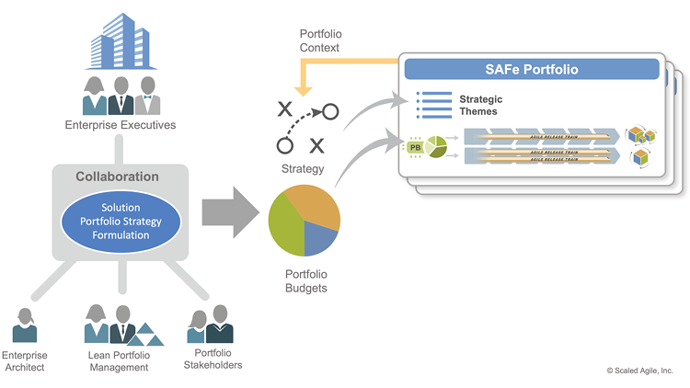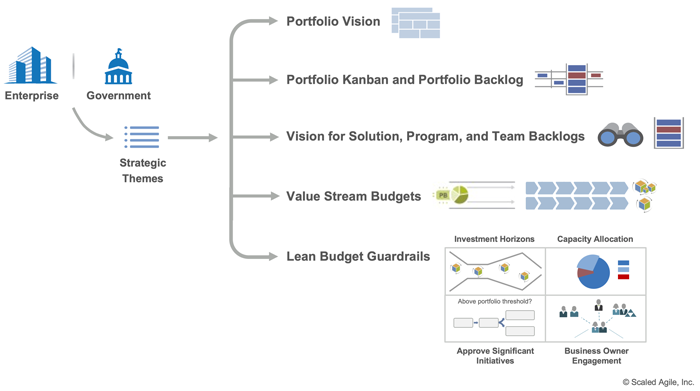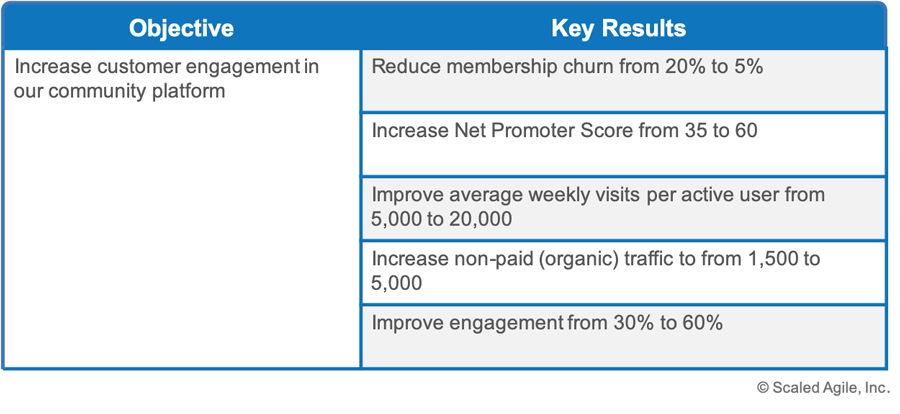Innovation distinguishes between a leader and a follower.
—Steve Jobs
Strategic Themes
Strategic Themes are differentiating business objectives that connect a portfolio to the strategy of the Enterprise. They influence portfolio strategy and provide business context for portfolio decision-making.Details
Strategic themes offer a way to align the business strategy of an Enterprise or Government agency with a SAFe portfolio. Working together, enterprise executives and portfolio stakeholders analyze various inputs to establish a set of strategic themes (Figure 1). These are specific, differentiated business goals that communicate aspects of strategic intent from the enterprise to the portfolio.

Strategic themes also provide a mechanism for aligning the business strategy of the Enterprise (or Government Agency) to a SAFe solution portfolio, as Figure 2 illustrates. They are the key differentiators that drive the future state of a portfolio. Since strategic themes are a reflection of enterprise strategy, they tend to be relatively stable and don’t change that often. Annual updates seem to work for most enterprises.

The Influence of Strategic Themes
Given that strategic themes influence portfolio strategy and provide business context for portfolio decision-making, they affect many things, as illustrated in Figure 3. Specifically, they affect:
- Portfolio Vision
- Value stream Budgets and Guardrails, which affect investments in Solutions by Horizon
- Portfolio Kanban and Portfolio Backlog
- Vision and Large Solution, ART, and Team backlogs

Each aspect of Figure 3 is described next.
Portfolio Vision
Strategic themes are direct inputs to the portfolio vision. They may impact solutions, partners, key activities, customer segments, and revenue streams, and other portfolio business model elements.
Investment Horizons
Strategic themes help the portfolio align solution investments with the time horizons of the enterprise.
Value Stream Budgets and Guardrails
Strategic themes profoundly influence value stream budgets, which provide the investment and allocation of people needed to accomplish the strategic intent. They trigger the following kinds of questions:
- Do the current investments in value streams reflect the changes to the business context?
- Are the current value streams the right ones? Should we start a new value stream, or end an existing one?
- Do the Guardrails provide the proper guidance for investments? Are we spending the appropriate amounts in existing and new products and services? Do we have a sufficient level of funding for operations, infrastructure, maintenance, and support activities?
Portfolio Kanban and Portfolio Backlog
Strategic themes provide insight into the Epics that are necessary to achieve the vision. Further, they serve as inputs to decision-making criteria in the Portfolio Kanban system, where they:
- Impact the identification, success criteria, and prioritization of items in the funnel and backlog states
- Warrant reference and consideration in the Lean business case
- Impact the definition of the Minimum Viable Product (MVP)
Vision and Solution, Program, and Team Backlogs
Strategic themes have an influence on the vision and backlogs for development at every level. They help determine the values of Weighted Shortest Job First (WSJF) that determine epic priorities. Solution and program epics that flow from the portfolio, or arise locally, are also influenced by the current themes. Due to their importance, strategic themes will often be presented (and repeated) by the Business Owners during Program Increment (PI) Planning. Moreover, strategic themes provide vital conceptual alignment across Agile Release Trains and Solution Trains.
Defining Strategic Themes
Since strategic themes are a vital tool for communicating the strategy to the entire portfolio, providing a simple, memorable message that influences everyone involved in solution delivery is critical. Strategic themes can be defined by a phrase or by using the Objectives and Key Results (OKRs) template.
Below are a few examples of strategic themes:
- Appeal to a younger demographic (a video streaming service)
- Cloud and mobile-first (a financial institution)
- Implement product support for trading foreign securities (a securities company)
- Lower warehouse costs (an online retailer)
- Implement single sign-on across applications (independent software vendor)
Figure 4 provides an OKR template that can be used to define, organize, and communicate critical information about a strategic theme. “It provides a simple approach to create alignment and engagement around measurable and ambitious goals.” [2]

There are two primary fields in the OKR template:
- Objective – a memorable description of what you want to achieve. They should be short, inspirational, and challenging.
- Key results – are measurable success criteria that can be used to track progress towards the objective. For each objective, there should be two to five key results
The goal of using OKRs for strategic themes is to define and track their progress through concrete, specific, and measurable actions. “OKRs are frequently set, tracked, and re-evaluated – usually quarterly. OKRs exists to create alignment and to set the cadence for the organization. The goal is to ensure everyone is going in the same direction, with clear priorities, in a constant rhythm.” [2]
Learn More
[1] Ries, Eric. The Lean Startup: How Today’s Entrepreneurs Use Continuous Innovation to Create Radically Successful Businesses. Crown Business, 2011. [2] Castro, Felipe. The Beginner’s Guide to OKRs. https://felipecastro.com/en/okr/what-is-okr/
Last update: 21 September 2021





